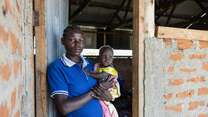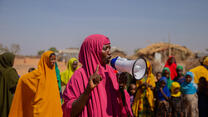WHO WE ARE
The mission of the International Rescue Committee (IRC) is to help people whose lives and livelihoods are shattered by conflict and disaster to survive, recover and gain control of their future. Our vision is that the IRC will lead the humanitarian field by implementing high-impact, cost-effective programs for people affected by crisis, and shape global policy and practice by sharing our learning and experience with others.
All IRC programs are designed to achieve meaningful change in people’s health, safety, education, economic wellbeing and ability to influence the decisions that affect their lives. The Violence, Prevention and Response (VPR) unit implements programming that prevents violence against women, children, especially girls, and other vulnerable groups, and responds to it when it does occur.
WHY OUR WORK MATTERS
Armed conflicts and natural disasters have spurred a global displacement crisis, with more than 60 million people displaced worldwide, more than half of whom are women and children. During crises, government institutions that guarantee basic human rights and protection to their citizens are broken down. Refugees, internally displaced people (IDPs) and other marginalized groups are extremely vulnerable and require protection against violence and human rights violations, and access to adequate legal and rights information. Most displaced people are hosted in developing countries, creating a precarious protection situation. They often lack legal status, have no legal protections, are at risk of exploitation and abuse, and are excluded from basic services such as health care and education.
Every five minutes a child dies as a result of violence.
Violence against children (VAC) affects half of all children globally, and children in conflict settings are at even greater risk. 60 percent of children aged two to fourteen—nearly one billion children around the world—experience physical punishment by their caregivers on a regular basis. In 23 countries, most of which are conflict-affected, one in five children experience the most severe and unthinkable forms of corporal punishment. In some countries, more than one in four girls and between one in ten and one in five boys experience sexual violence before the age of eighteen.
Research shows that violence causes harm in all areas of a child’s development, including how they grow, learn and relate to the people around them. Exposure to adversity and violence and the resulting toxic stress can lead to life-long physical and mental health problems, lower educational achievement and aggressive and violent behavior in adulthood.
One in three women will face gender-based violence (GBV) in her lifetime.
During times of conflict and crisis, as structures and support systems that protect women and girls are broken down, women are at an even higher risk of experiencing gender-based violence. Recent research found that one in five refugee or displaced women experience sexual violence. This is likely an underestimation as experiences of violence tend to be underreported.
Approximately 150 million girls under the age of 20 have been subjected to forced sexual acts at some point in their lives.
Due to their gender and age, adolescent girls are incredibly vulnerable to violence in conflict-affected settings. Recent research conducted by the IRC showed 40% of girls in the DRC and 30% in Ethiopia experienced physical violence in the past twelve months. Belief that girls have less value and are less capable than boys results in denial of education, social isolation, exploitation, and early or forced marriage.
Additionally, other marginalized groups such as the elderly and persons with disabilities are often at an increased risk of violence and exclusion from basic services.
WHAT WE DO
IRC practitioners provide technical assistance to more than 30 country programs. Technical advisors are charged with staying abreast of the best available research and practices in their respective fields and sharing these with the IRC’s frontline teams. They also lead advocacy strategies to encourage partners and policy makers to adopt the interventions proven to be effective based on our research and experience.
The IRC has been working for nearly 30 years on programming focused on preventing and responding to violence against the most vulnerable groups in conflict contexts. Our high-impact programs are designed based on the best available evidence to achieve measurable improvements in the lives of those we serve.
Our specializations
Women’s protection and empowerment
In 25 countries across Africa, Asia and the Middle East, the IRC’s innovative programs focus on providing care to women and girls who have experienced violence, as well as tackling the root causes of abuse, restoring dignity of survivors, and creating opportunities for women and girls to rebuild and transform their lives and communities.
- Provision of services: Providing essential health and psychosocial services to survivors of violence is the bedrock of the IRC’s approach. For women and girls subjected to violence, the ability to access immediate health care and psychological support can be the difference between a life lived with dignity and one with shame. 11,400 survivors of gender-based violence received the IRC’s support in 2015.
- Violence prevention: The IRC tackles root causes of violence against women by working with community groups, local institutions and governments. Our programs help change community attitudes toward women and girls, supporting them to realize their potential and advocate for their rights.
- Engaging men in accountable practice: The IRC’s Engaging Men in Accountable Practice program reduces violence against women by focusing on efforts to engage men in examining and challenging destructive notions of masculinity, gender and power in post-conflict settings, while being guided by the voices and inputs of women and girls.
- Empowering adolescent girls: IRC programs specifically work to improve the prevention of and response to violence against adolescent girls in humanitarian settings, including safe space programming and life skills training, mentoring by older adolescent girls, and engagement with service providers and caregivers to better prioritize and meet their needs. GIRL SHINE, our program designed specifically for adolescent girls, builds off lessons learned from research done in IRC programs for adolescent girls.
- Women’s economic empowerment: When women have control over resources, it enhances their status in their households and communities, providing more chances to participate in the decisions that affect their lives. The IRC’s EA$E (Economic and Social Empowerment) model gives women access to financial resources and provides opportunities to both women and men to create more equitable gender dynamics within their households.
Child protection
The IRC takes a family-based approach to child protection, recognizing that violence in the home must be addressed at the family level.
- Immediate protection: More than one billion children are living in conflict-affected areas, of which 300 million are under the age of five. The IRC is consistently among the first NGOs on the scene in crisis and conflicts. We immediately work to identify and protect children at risk of being harmed or who have been harmed. The IRC helps children recover from post-traumatic stress, sexual abuse and other physical and psychological injury.
- Children outside of family care: Children affected by conflict, particularly unaccompanied children (UAC) and those outside of family care, are at even greater risk of sustained stress and have less access to protective services. Some estimates put the number of UAC at over one million globally. In addition, at least tens of millions of children are living and/or working on the street, with some estimates as high as 100 million. It is safe to assume that because of their extreme vulnerability, all children connected to the street experience violence. The IRC is a leader in family placement, including tracing and reunification, for children who have been separated from protective care.
- Protective environments: Children with safe and supportive mentors have been shown to be resilient to threats to their survival and development. The IRC creates protective environments for children inside and outside the home. For example, the IRC has been implementing parenting programs since 2010, in various contexts using our evidence-based parenting program, Families Make the Difference. In 2015, the IRC’s child protection programs provided 24,555 families with parenting support.
- Safe healing and learning Spaces for children (SHLS): Through the IRC’s Safe Healing and Learning Spaces, children receive psychosocial support that improves their ability to cope with and heal from trauma, exposure to violence and conflict. Comprehensive SHLS programming provides children with recreational activities, social and emotional learning support, literacy and numeracy skills and works with parents to ensure a standard, comprehensive and holistic package of support for children in emergencies.
Protection and rule of law
Access to justice is “the ability of people to seek and obtain a remedy through formal and informal institutions of justice, and in conformity with human rights standards.” (United Nations Development Program)
Without clearly defined and implemented laws, a functional court system or a well-trained police force, societies are at risk of descending into chaos and violence. The rule of law is eroded in times of conflict and natural disaster, and many people lack access to the legal system. Women experiencing violence in refugee camps, people who have lost their legal documents in a natural disaster and returning refugees who find their land occupied, all need support from the legal system.
The IRC’s protection and rule of law programs help to restore the dignity of individuals by providing them with a voice to claim their rights and entitlements, supporting them to seek remedies for their claims, and empowering them to hold justice institutions—informal or formal—to account.
- Protection monitoring: The IRC works in coordination with other organizations to collect, analyze and verify information from IDPs and refugees to identify human rights violations and protection risks they have encountered. This ensures that vulnerable groups are not only safe and free from exploitation and abuse but also have free and full access to basic services. In 2015, in Lebanon and Iraq, the IRC assessed 800,000 people for protection risks and referred 30,000 to necessary services.
- Increasing legal awareness: In conflict, legal systems and services break down and become inaccessible. In many contexts where the IRC works, people are unable to solve their legal problems and are often unaware that legal remedies exist. The IRC works with local actors to empower people by increasing their legal knowledge.
- Providing legal assistance: In areas affected by conflict and disaster, it is difficult to find or afford a lawyer. The formal justice system remains largely inaccessible, and legal disputes are settled through informal justice systems. The IRC (1) provides independent and free legal advice; (2) trains members of the community to become paralegals who play a crucial role in providing basic legal support; and (3) supports people to obtain documentation such as birth certificates and identify cards to access state-delivered services like education, health care and social benefits.
- Strengthening dispute resolution mechanisms and institutions: The IRC works with informal justice systems to strengthen their skills and capacities to solve disputes in line with national and international standards, particularly for the most vulnerable populations.
HOW WE DO IT
We leverage our specializations to deliver comprehensive programming to prevent violence and respond to violence when it does occur. Areas where the protection efforts described above converge include:
Family violence
Violence against women and violence against children are intimately related and often co-occur. Children exposed to intimate partner violence (IPV) in the home are more likely to become victims of IPV in adulthood. Violence experienced by children has long-term effects that extend into adulthood, increasing their chances of becoming perpetrators of violence themselves and affecting their overall development, leading to other long-term negative social consequences.
Historically, programs to respond to violence against women and violence against children have had parallel (i.e. unlinked) programming. The IRC is creating integrated and yet specialized responses to family violence that recognize common and complementary expertise to solve the problem of family violence for women and children. This includes more comprehensive responses, including programs that prevent and respond to violence at an individual and a family level, while maintaining the confidentiality and safety of survivors.
Case management
The IRC provides case management programs to children and women who have experienced violence. Our approach includes creating harmonized case management and data collection methods that safely link key information across programs without breaking confidentiality. This includes linking the identification of vulnerable children in need of individualized, age appropriate support to case management specifically for female survivors with the recognition that violence against women requires a unique approach to ensure the ongoing empowerment and safety of female survivors. In 2015, our case management programs counseled and cared for 36,800 children, trained 9,525 child protection workers on case management, and provided services for 11,400 women and girl survivors of gender-based violence.
Clinical care trainings
The IRC provides training tools, guidelines and curricula to support medical providers in giving competent, compassionate and confidential care to adult and child survivors of violence. Evidence shows the IRC’s Clinical Care for Sexual Assault Survivors (CCSAS) training tool improved the quality of clinical care for survivors of violence in diverse humanitarian settings worldwide.
Adolescent girls
One in seven girls in the developing world will be married before the age of 15 and at least 200 million girls and women have undergone female genital mutilation (FGM) in 30 countries. The IRC’s programs for adolescent girls are driven and led by girls in a way that is owned and empowers them long into the future. Adolescent girls are a population where the approaches used in programs designed to respond to violence against women and those designed to respond to violence against children converge. Given their unique vulnerabilities and potential, bringing together different expertise to empower adolescent girls is imperative. When a girl receives seven years of education she marries four years later and has 2.2 fewer children. If she is able to decide when to marry and have children, she and her children are more likely to lead healthier, productive lives and exit the cycle of poverty. The IRC has several programs specifically designed to respond to the needs of adolescent girls.
- COMPASS (creating opportunities through mentoring, parental involvement and safe spaces): The IRC engages mentors to work with young girls to strengthen their life skills, build their confidence and support them in their pursuit of life goals. Parents participate in sessions discussing gender inequality, gender-based violence and parenting, and the effects those have on the development and opportunities for their daughters.
- Empowerment of adolescent girls and young women: GIRL EMPOWER is an innovative IRC program designed to equip girls with the skills and experiences necessary to make healthy, strategic life choices and to stay safe from abuse and sexual exploitation. GIRL EMPOWER responds not only to girls’ heightened exposure to harm in humanitarian and post- conflict settings, but also to the vital roles they can play in building healthier families and stronger communities.
Centrality of Protection
The VPRU is committed to Protection both as a sector and as a cross-cutting issue applicable across all humanitarian interventions and actors – as enshrined by the IASC Policy on Protection in Humanitarian Action.
- Protection Mainstreaming: Services need to be provided to affected populations in a way that prioritizes their safety and dignity, ensures their meaningful access, allows them to hold service providers accountable, and promotes their participation and empowerment. The VPRU has produced guidance and tools to apply these basic principles across all sectors, and to monitor implementation and impact for affected populations. These tools have been adopted and adapted by the Global Protection Cluster (GPC), and are now promoted and used across the global humanitarian coordination structure.
- Community-Based Protection (CBP): Affected populations and local communities have the knowledge and skills to help drive their own safety and security. For the VPRU, CBP forms a set of dedicated interventions that empowers communities to identify, analyze, and address protection risks they face.
- Capacity Building: As a global lead on Protection Mainstreaming, the VPRU invests resources to build the capacities of IRC staff, national partners, and field coordination mechanisms. This is achieved through organizational and technical capacity building. The VPRU also makes use of “remedial action funds” to fund quick impact activities immediately following a workshop.
- Inter-Agency Standing Committee (IASC) GBV Guidelines: Recognizing the critical, cross-sectoral nature of GBV prevention and risk mitigation, the VPRU hosts the inter- agency global coordinator for the IASC GBV Guidelines and works to integrate practical GBV prevention and mitigation interventions across global humanitarian response.
- Global Policy & Practice: The VPRU is active in global inter- agency coordination mechanisms, notably through the Global Protection Cluster (GPC) and its Areas of Responsibility (i.e. GBV and Child Protection). The VPRU participates in the development of global policy and practice (e.g. IASC Policy on Protection), and co-chairs the GPC Task Team on Protection Mainstreaming together with OCHA.


